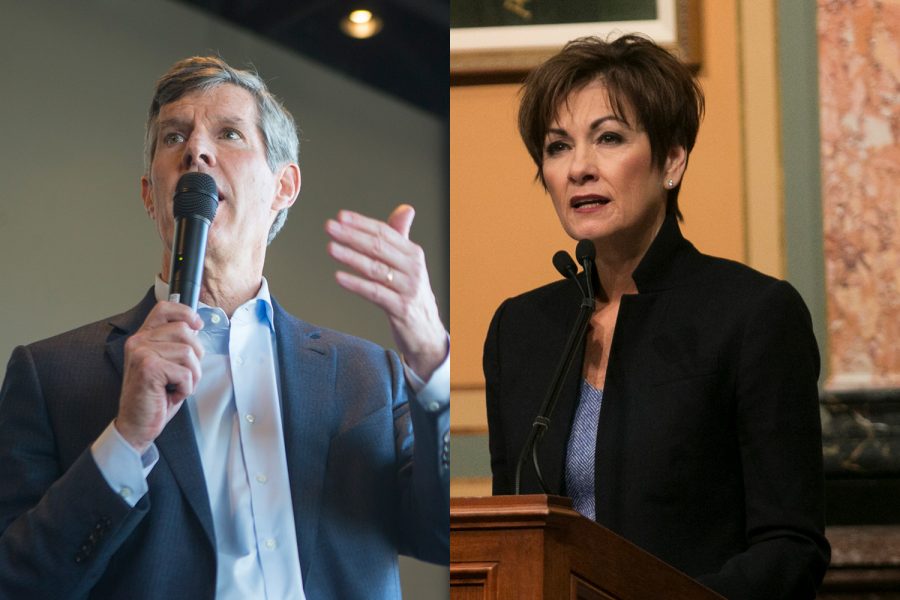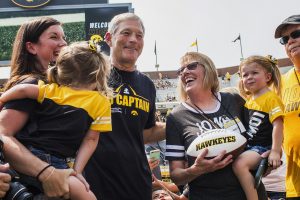Iowa Democrats still lag Republicans in voter registration, but the gap is steadily closing
While rates of registered voters won’t predict the outcome of the midterm elections, the numbers give a clue into which party voters may lean toward. The wild card? Independent voters.
Democrat Fred Hubbell (left) and current Republican Gov. Kim Reynolds are running for Iowa governor.
November 1, 2018
With four days until the midterms, Republicans continue to lead in statewide voter-registration totals, but Democrats are closing the gap.
According to data released Nov. 1 by the Iowa Secretary of State, there are currently 649,944 registered active Republican voters and 627,431 registered active Democratic voters. Since January, the gap between party registrations has narrowed from about 48,000 to approximately 22,500 voters.
“It’s still a significant gap, so we’re pretty confident we’re going to perform well on Election Day,” said Bill Gustoff, a Republican Party of Iowa Central Committee member representing Polk County in Iowa’s 3rd Congressional District.
However, said Timothy Hagle, a University of Iowa associate professor of political science, registration totals don’t necessarily correspond with election results. The numbers do provide insight into which candidates people are likely to vote for.
People are still able to register to vote on Nov. 6 at their polling places, provided they bring along appropriate documentation.
RELATED: 2018 Voter Guide
Both parties have experienced a decrease in overall registration totals since 2016, a typical result in a midterm election year.
“The turnout generally is quite a bit lower in the midterms,” said Cary Covington, a UI associate professor of political science. “What you expect to see is a return to voting patterns that reflect the baseline in districts and states rather than the groundswell of voting that occurs because it’s motivated by a choice between presidential candidates.”
Despite the general decrease, Democrats have seen an increase in voter registration of approximately 6.25 percent since March. Republicans have experienced a gain of around 1.75 percent.
“In a baseline vote, Republicans are historically more motivated to vote, they tend to turn out more than Democrats,” Covington said. “This midterm is more unusual because the Democrats have an enthusiasm level that equals or exceeds the Republicans’, and that is usually not the case.”
Christopher Taylor, the chair of the Johnson County Democrats, said the growth in party registration has been slowly building up over time. And Kyle Kondik, the managing editor of Sabato’s Crystal Ball, a nonpartisan political analysis newsletter run by the University of Virginia Center for Politics, the Democratic Party as a whole has been pushing for more consistent base engagement since 2016.
From the Republican side, an uptick in national engagement came in the beginning of October, Kondik said. The recent economic improvements across the country have been a big draw for the voter base, said Thomas Hansen, the chairman of the Winneshiek County Republican Party.
RELATED: Efforts to attract the youth vote continue as Election Day approaches
Along with economic trends, two other national factors have been commonly cited among party leaders as those that may motivate people from both sides of the aisle to vote in the midterms: the controversy surrounding Brett Kavanaugh’s confirmation to the Supreme Court and immigration from Central America.
“The main effect [of Kavanaugh’s confirmation] was to mobilize and activate each party’s respective bases,” Covington said, noting that was in the short term. “I think the Republicans got a boost they didn’t have before … and it helped level the gap in enthusiasm between the two party bases.”
There are also currently 719,889 no-party, or independent, active voters registered across the state. Hagle said turnout rate of no-party voters usually ranks below both Republicans and Democrats. Activating members of this group is key to ensuring a victory.
“We’re often looking at numbers combining Democratic and no-party voter registration, because we know we can lean on those independent voters during certain election cycles to sway their vote one way or the other,” said Josh Ginger-Goodson, the vice chair of Boone County Democratics, referring to the campaign of Democratic candidate J.D. Scholten in Iowa’s 4th Congressional District. “The lead doesn’t concern us a whole lot because we know the independent voter registrations outnumber the Republicans.”
But until polls close at 9 p.m. on Election Day, nothing is certain.






